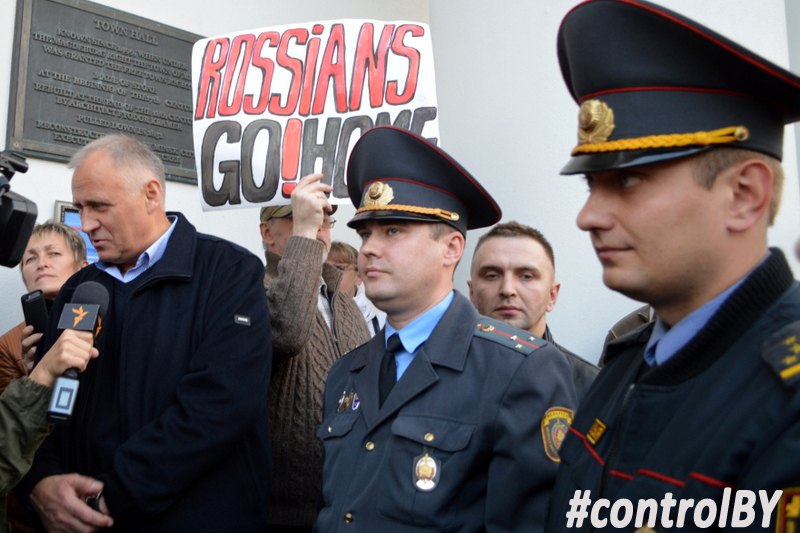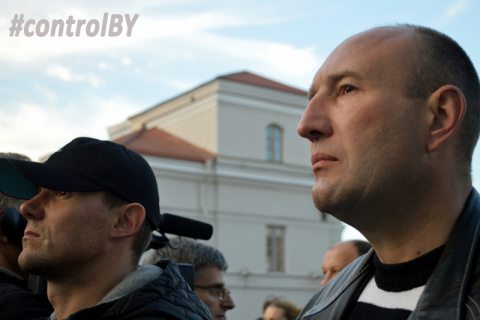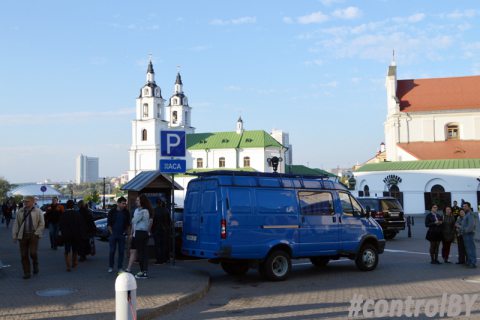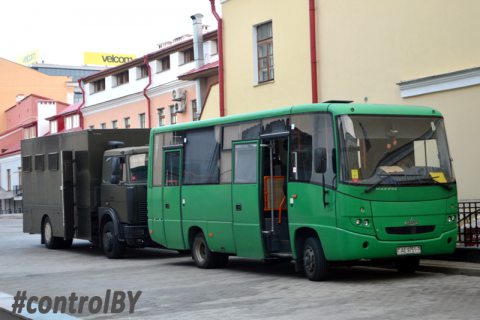Report on results of monitoring of People's Assembly in Minsk on October 4
Conclusions
October 4, 2015 in Minsk the People's Assembly regarding the construction of a Russian military base in Belarus took place in Minsk.
The mass event was peaceful. The absence of an application for its conduct, as required by law, is not a reason to limit the freedom of peaceful assembly. The fact of drawing of reports of administrative offense against the speakers at the assembly, Mikalai Statkevich, Anatol Liabedzka, Uladzimir Niakliayeu, Ales Mekh and Aliaksei Marachkin can be regarded as interference with the mass event on the part of the police, though we have no note as positive the practice of drawing up violation reports on the spot, without physical detention of the persons against whom the administrative proceedings are brought. It is also unclear why passport data were taken from some speakers (Maksim Viniarski).
As a result of the observation, the following negative moments were registered:
- the police aren't properly designated and cannot be identified, i.e. the authorities don't implement their positive duty of securing peaceful assemblies, as far as it would be unclear who to address were there be any conflict situations;
- the fact of regarding a peaceful assembly as an administrative offense is a form of repressive persecution for participation in peaceful assemblies, which doesn't correspond to the international legal standards of freedom of peaceful assembly;
- the police refuse to speak with observers and advise them to ask all questions in writing to the press-service. The problem is that there is no representative of the press-service at the event. 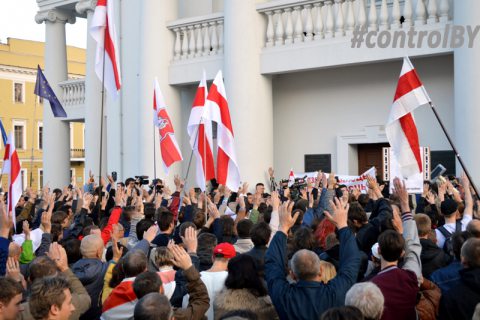
Background Information
At the meeting of September 23, 2015, the organizers invited people to come to another meeting on October 4 to protest against the construction of a Russian military base in Belarus. Topical news about the signing of the appropriate statement by politicians and calls to come to the meeting were spread through mass media.
During the mass event of October 4, 2015, the public control was carried out continuously by 8 observers who have been trained and are properly marked (by blue vests and badges).
Course of Mass Event
1. Initially, people gathered near the town hall and came close to its entrance at about 5 p.m. They unfurled flags, banners and posters. The speakers spoke in turn through a manual megaphone. 15 minutes after the beginning of the rally, three police officers in the uniform, wearing breast signs, started asking the personal information of the speakers and putting them down in the reports of administrative offenses. They stood beside the speakers until the end of the event. The crowd of participants repeated slogans after the speakers, people sang songs.
2. According to approximate calculations, the number of participants increased from about 150 in the beginning to about 470 at the end of the rally.
3. It was hard to determine the number of police officers, as most of them didn't wear any badges or uniform. There were three road policemen in the uniform, three policemen in the uniform with the inscription “Police” and about 25 more were dressed in civilian clothes with distinctive signs (headphones, walkie-talkies). The leadership of the Main Police Department and the district police departments were also dressed in civil clothes without identifying marks. 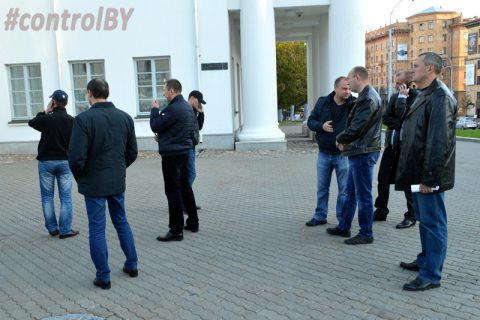
4. The observers spotted a blue micro-bus with cameras on the roof, and a bus with police officers in civilian clothes near the Georgian Embassy. Another bus and a paddy wagon were noticed in the yards. Policemen in the uniform with the inscription “Rio Police” were sitting in the latter one.
5. While compiling violation reports the police didn't explain the right and duties to the persons, against whom the reports were compiled. The essence of the alleged offenses wasn't explained either.
6. There weren't created any obstacles in getting to the place of the assembly. There weren't any obstacles to the work of the media and observers on the part of the police either. However, during the communication one of them tried to prove the illegality of the observation.
7. The organizers of the assembly weren't designated.
8. There weren't registered any calls to violence on the part of the action participants.
9. Participants of the assembly were wearing T-shirts "I am against Russian military bases!" and "PTN PNH from Belarus”, posters "Russian military base makes us a target. No database - No War", “Stick your military bases in the a..”, “Russians Go Home”, “Russian military bases are the occupation of the country”, “We need peaceful sky”, the streamer “For Statehood and Independence. No to the Russian military base in Belarus. No to dependence on the Russian regime”, some topical pictures with the image of Putin and the Russian flag and the words "Go Home".
10. The following symbols were used: white-red-white flags, flags of the United Civil Party, the campaign “European Belarus”, the “Young Front” - on flagpoles, flags of the Ukraine.
11. The people chanted slogans “Long Live Belarus!”, “Glory to the Nation”, “Russia Is War”, “Shame”, “God Save Belarus”, “Independence”, “Mikola”, “Freedom for Political Prisoners”.
12. Speeches were delivered through a megaphone by Mikalai Statkevich, Uladzimir Niakliayeu, Anatol Liabedzka, Viachaslau Siwchyk, Aliaksei Marachkin, Ales Mekh.
13. An observer tried to ask policemen in the uniform about the number of policemen who were guarding the event, but they only agreed to introduce themselves and advised him to appeal to the press-service of the Main Police Department of the Minsk City Executive Committee. No information was received from the employee of the Main Police Department Maksim Hryshchanka, who was present at the action, dressed in civilian clothes.
14. The organizers didn't demand anything from the participants.
15. The police didn't use violence during the mass event.
16. The observers didn't see any ambulance cars.
17. The police started dispersing from the place of the assembly at about 6.05. p.m.
Recommendations
to law enforcement officials:
1) to maintain public order during mass events wearing the uniform and be designated with identification cards (badges or breast signs);
2)to designate a contact person among the policemen for communication with observers, mass media and organizers of the mass event;
from the number of police officers to communicate with observers, the media and the organizers of mass events;
3) to stop the administrative proceedings in respect of the speakers, as they were just exercising the right to freedom of assembly, guaranteed by Art. 35 of the Constitution of the Republic of Belarus, Art. 19 and 21 of the International Covenant on Civil and Political Rights and other international instruments on human rights.
to subjects with the right of legislative initiative:
4) to initiate changes in the legislation to bring it into line with international standards on freedom of peaceful assembly.



